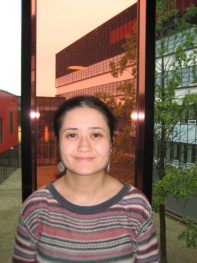Floaters on Faraday Waves: Clustering and Heterogeneous Flow
Promotion date: 6th of July, 2012
Promotor: Prof. dr. Detlef Lohse
Assistant promotor: Dr. Devaraj van der Meer
| In this Thesis, a monolayer of macroscopic particles floating on a surface wave was studied. The liquid was pure water so that the particles are at a water-air interface. The particles are hydrophilic polystyrene spheres with average radius around 0.31 mm and they are slightly heavier than water. The surface wave was a Faraday wave, which is a wave generated at a liquid-air interface when a layer of liquid is exposed to a vertical periodic driving. We demonstrated the role of the particle concentration on the spatial distribution of our hydrophilic heavy spheres floating on a water standing Faraday wave. At low concentrations, we observed that our floaters form clusters at the antinodes of the standing wave. On the other hand, at high concentration with the same floaters, we observed that inverted patterns, i.e. clustering patterns at the nodal lines of the wave, form. The wave drift and the attractive capillary interaction are the mechanisms driving the clusters. By evaluating both in an energy calculation, we confirmed the experimentally observed clusters. Heterogeneous dynamics of the floaters on nonlinear chaotic waves, namely capillary Faraday wave with a wavelength order of floater size, is the other subject studied experimentally. We observed that the resultant flow is composed of the floater domains. A morphological approach was developed to quantify the deformation of the domains in time. This is an alternative way to characterize the heterogeneous dynamics generated by such a particulate flow. |
Your PhD project was of a fundamental nature. Are there applications possible in future?
The basic principles studied here are used already in practice somehow. For example removing impurities in a melted metal surface, and removing plastic contaminants of a paper pulp by injecting gas bubbles.
To design these methods in an efficient way, the knowledge on agglomeration floating on perturbed dynamic interfaces is required. The theories, up to now, have only considered static interfaces, and so how the interface dynamics influences the floater agglomerations is still unknown. It is not a renowned subject in science, still society can benefit from its findings, I am convinced.
A further potential application would be cleaning of sea surfaces. A huge amount of waste is disposed into the sea on a worldwide scale, and the consequences are a threat to all living habitants. Effective and less energy consuming methods are needed to be developed. We found that creating surface waves can enhance floater agglomerations in an organized way. The segregation of different types of contaminants would be possible since the contaminants having different physical properties experience the wave drift in an opposite direction. Therefore, recycling contaminants from clumps of waste on sea surfaces can be efficiently satisfied in a less energy consuming way.
Also social sciences can benefit from these findings. We showed that two competing forces only can explain why the floater patterns need to exhibit emergency of order. An analogy between emergency of order in social areas, such as why people move together in an organized way in a crowd, would be valuable.
Did you feel part of the Mesa+ society during your project?
We had some colleagues in the Multiscale Mechanics group led by Professor Stefan Luding. Numerical analyses were very helpful for us as the MSM-group has a vast experience in analyzing complex non-linear systems on long-term timescales. They eliminated the noise parameters and effects, and led us straight to the heart of the matter.
The morphology approach of floater clusters, on the other side, promises to become a new area of research, understanding collective motions and their interactions with large area variables.
How did you develop personally as a researcher and scientist?
I rediscovered my creative spirit, in some way. First I was an artist and attended the art classes in Turkey. Then, I developed as a mathematical student. Now, here in Twente, I learned to draw in detail what is happening, translating the mathematical theories to visualize the flows actually taking place. This leads to creative thought and also is a great way to communicate one’s results to other people, both within the research society as to other researchers around and within the society to valorize our research. I enjoyed doing this very much so. It was a great personal discovery.
Experimenting in fluid dynamics is hard to do. I did manage to create some tools in this area of research. Hopefully future PhD’s in Twente will benefit from this.
What are your future plans?
In August, I am planning to become a post-doc at the new institute for science and technology in Okanawa, Japan. This will be an exciting time, I presume, especially as the institute is starting from scratch. It is a challenge to help building this up.
After that, I would like to go back to my homeland Turkey. Starting my own research group is my biggest wish, preferably fundamental aspects of fluid dynamics.
What in your opinion is important for Mesa+ in future?
Organization meetings are important, especially for PhD students. When just starting, some of them are in danger of losing their way. In the beginning, it is important to show your results and not trying to build theories of everything. Fellow PhD’s can be helpful in this process.
I really appreciated the nice approach towards bachelors, masters and PhD’s. Science director Dave Blank was always interested and has a nice view on scientific research. This is a great motivation for young people.

